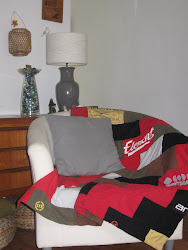 Do not be put-off by the idea of combining your soft-furnishing skills with a little woodwork (today's tips could be very loosely said to involve woodwork, it's a staple-gun actually).
Do not be put-off by the idea of combining your soft-furnishing skills with a little woodwork (today's tips could be very loosely said to involve woodwork, it's a staple-gun actually).I bought a tartan-topped foot-stool at the boot fair (£1.50- see later in the week for that early-morning escapade). The legs and wood colour match other furniture we have, specifically 1930s arm chair I blog in. The tartan, although a style to work, is not my bag, and was a little saggy.
YOU WILL NEED:
- a staple gun ideally (please take care, NEVER look into firing end when refilling/un-jamming gun, very unsafe)- you could use small tacking nails and a hammer but you will need a 'crafting buddy' to help hold and hammer.
- Fabric that looks 6cm larger in diameter/width than footstool top. Relatively hard-wearing.
- Scissors
- Fabric/PVA glue
- 'Trim' e.g. ribbon or braiding or plaited fabric for edge detail.
- Cut cover off carefully, try not to snip pad or sponge beneath. If the way this fabric has been attached is easily levered-out you could do this instead. KEEP FABRIC for later template.
- Cut your fabric with extra 3cm minimum around all sides.
- Start upholstery with folding edge of fabric under and stapling at 'north'.
- Stretch fabric well to 'south' of stool and staple again.
- Apply same technique to 'east and west' respectively, making sure there are even amounts of fabric loose.
- Work each area separately now, stapling in from compass points following centre, right and left pattern to stapling. Keep tucking and pulling tight. Mind your fingers.
- Rotate stool and complete each 'corner/loose edge.
- Trim any excess to neat edge.
Neatening:
- Use fabric glue to stick your braiding/ribbon, a small section at a time, over the visible staples. PVA glue will work, and be strong enough but it dries with a crisper finish and may show through a thin fabric. Apply the glue to the stool NOT ribbon.
- Trim neat.
- Layer-up braiding decoration for a fuller look.
The marble applique fabric I used was a cushion I had previously made. They are marbles of felt with hand-embroidery sewn to a hard-wearing cotton-linen fabric. You could buy patterned fabric or sew a design to your piece pre-stapling. Fabric-paint could add a free-er look decoration, maybe flowers or text. Iron to fix before upholstering because some fabric pads are synthetic and would melt under the iron-heat.
Have fun, it'll become your pride and joy. You can apply the same technique to table-tops and chairs. Trick is to buy the product cheap or use something old so it won't matter if it doesn't work first time, and it will usually be an improvement anyway.











